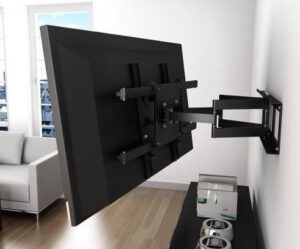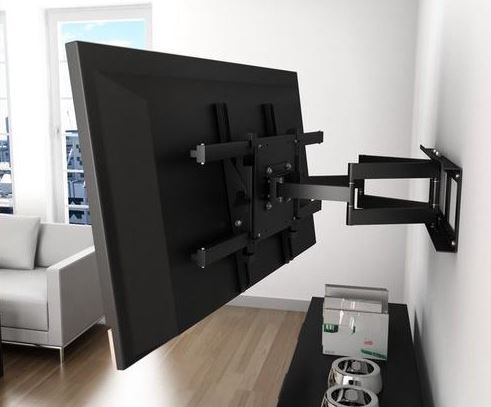When mounting a TV, you need to have a few things handy: a stud finder (to mark the location of studs in the wall), a Phillips screwdriver, and a power drill. You will also need a level to make sure the TV is not crooked once mounted.

Start by determining the ideal height for your TV. This will depend on the seating arrangement in the room, but you should aim for eye level. To learn more tricks on TV Mounting keep reading the article below.
The height of a TV mount is an important factor in comfort and viewing. A TV mounted too low may cause neck strain, and one that is mounted too high can create a glare on the screen that makes it difficult to watch. A general rule of thumb is to mount the TV at eye level when seated. This will provide a comfortable viewing angle without causing strain on the neck.
The recommended TV mounting height can vary depending on the size of the television and the room layout. When deciding on a mounting location, consider the seating arrangement and the average height of the viewers in the room. It is also important to keep in mind any obstacles that could obstruct the view of the TV, such as furniture, shelves, or architectural features.
Once you have a rough idea of where to mount the TV, use a stud finder to locate wall studs. A stud finder is an inexpensive tool that can help you save time and money by eliminating the guesswork involved in finding a good location for your mount. Once you have located a stud, mark its position with a piece of painters’ tape. This will prevent you from drilling into drywall and leaving useless holes in the wall.
If you plan to mount the TV above a fireplace, be sure to take into account that the heat and smoke can damage electronics. The bottom of the television should be positioned at least two inches above the top of the fireplace mantel.
To determine an optimal TV mounting height, sit on the furniture you normally use to watch TV and get a feel for how high you can comfortably place the screen. Alternatively, you can measure the distance from your eyes to the center of the TV screen using a strip of low-stick painter’s tape. The point at which the tape intersects with the vertical and horizontal corners of the screen is the center of the TV.
Aesthetics
The TV mount will be an integral part of your living space, so you should choose one that is visually appealing. Fortunately, there are several options to consider.
A fixed wall mount sits flush with the wall, eliminating the need for a bulky TV stand and creating a clean and sleek look. This option is great for small rooms or if you want to conceal the mount behind furniture. You can also choose a full-motion mount, which allows you to tilt the TV up and down to reduce glare or fit in corners. These mounts are a bit more visible than fixed mounts, but you can hide them behind your furniture to keep the room looking tidy.
An articulating arm mount is another option that provides unmatched flexibility. These mounts allow you to swivel the TV, which can be beneficial for conference room settings where multiple people will be viewing the screen from different positions. You can also choose a mount with a gas spring arm, which makes movement smooth and easy.
Another way to improve the aesthetics of your TV is by installing a recessed mount in the wall. This type of mount can be painted to match the wall, which will create a seamless look. You can also choose a frame mount, which will hold your TV like a piece of artwork and blend seamlessly into your decor. This type of mount is available in a variety of finishes, including wood and marble effects.
Before you decide on a TV mount, it is important to experiment with the height of the TV and your seating arrangement to find the ideal position. It is recommended that you mount the TV between 42 and 60 inches off the floor to ensure a comfortable viewing experience. A good way to determine the best mounting height is by using a stud finder or other means to locate studs and mark their location on the wall. Using a stud finder will help you avoid drilling into electrical or plumbing pipes and make your project easier. You should also consider purchasing cable management solutions, such as cable clips or raceways, to hide unsightly cables and maintain a clean and organized appearance.
Cable Management
A TV mount frees up space on a console or media cabinet, making it easier to access the ports at the back of your TV and to add other equipment like a set-top box or gaming system. It also allows you to reposition your TV for a better viewing angle without having to move furniture or rearrange wiring. This is especially beneficial for homes with children, as it prevents them from reaching over the TV to play with or touch it, which could cause damage or a dangerous fall.
When choosing a mount, make sure it is rated for the weight of your television and has enough stability to hold it when in use. Look for a mount made from materials that can withstand impacts and rough handling, such as steel or aluminum, to ensure it won’t come loose over time. Check the UL listing to verify that it meets stringent safety standards.
Most VESA-compatible mounts have a plate that attaches to the back of your TV and arms that fit into the holes in a wall or other mounting surface. Some may require some light drilling to create these holes, but the overall installation process should be simple and straightforward.
Once your TV is mounted, it can be a great way to showcase art or other decor on the wall and create a more cohesive aesthetic for your home entertainment setup. However, the dangling cords can be distracting and mar an otherwise clean look, so consider installing a cable management kit to help conceal them. These kits include a plastic track that mounts to the wall over wires and a dual electric motor that flips your TV up when it is not in use, protecting it from damage while adding an elegant, minimalist look to your room.
One drawback of a TV mount is that it can be difficult to remove the mount from the wall, requiring some strength and assistance. This may be a problem in older buildings with plaster walls or, in some cases, in homes with wood paneling. Fortunately, there are many DIY solutions to this issue, such as using a tool that combines a drill and a power saw for a quick and easy installation.
Weight
With TVs getting slimmer and lighter, mounting them to the wall is an increasingly popular way to declutter and make a room feel bigger. While it might seem like a difficult project to undertake yourself, with some basic tools, a suitable mount, and a friend to help lift the television, it’s actually not that hard. The key is to think about where you want to hang the TV, the type of mount you need (fixed or articulating), the VESA pattern, and the weight and size of the TV itself.
Most TV wall mounts are designed to be used on drywall and come with all the hardware needed to attach them to the wall. To ensure that the wall can support the weight of the TV and mount, it’s important to use a stud finder to locate studs in the wall before drilling holes for the anchor points. A stud is a vertical piece of wood that makes up the structural frame of your wall. It’s much stronger than drywall and can support much more weight.
A stud is the best place to attach an anchor point, but if you don’t have access to a stud in your wall, there are other options. Some TV wall mounts come with a mounting plate that can be screwed into the wall, which provides several more anchor points to help ensure the wall can support the weight of the TV.
When choosing a mount for your TV, always check the VESA pattern on the back of the TV and the maximum weight rating of the mount to make sure they are compatible. This information should be listed on the packaging or in the TV’s manual. If it’s not available, you can often find the specifications for a specific model of TV on the manufacturer’s website.
A faulty mount or improper installation can lead to a very expensive mistake. If you’re unsure about how to properly mount your TV, it’s best to leave the job to professionals who can provide expert advice and ensure your walls are ready to support your new flatscreen.
